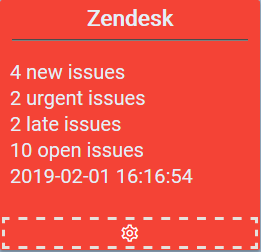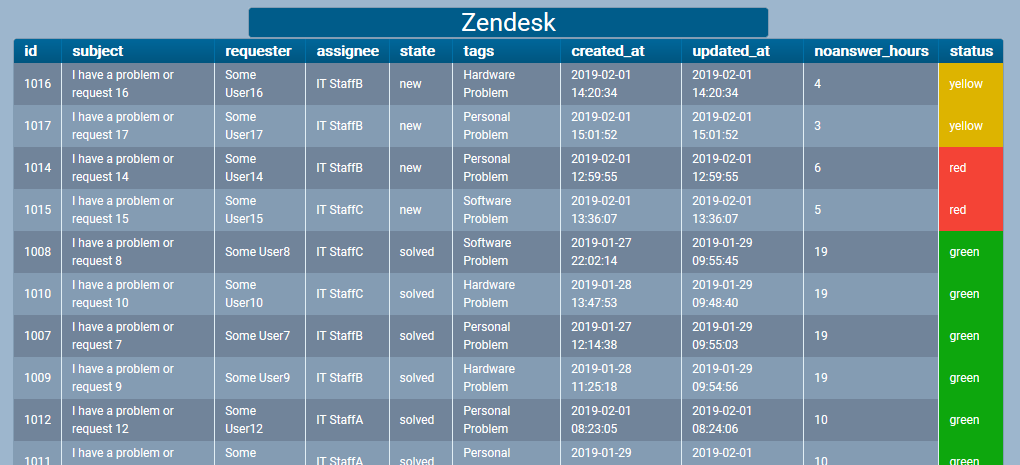CURE - Detector Zendesk
CURE - The homebrewed monitoring solution. Read more about it in my previous posts:
- CURE-Design
- CURE-Environment
- CURE-Database design
- CURE-Detector foundation
- CURE-Detector-step-by-step
- CURE-GUI
Background
The company is using different ticket management tools in the different branch offices. In one of the branches we’re using Zendesk, and of course I wanted to monitor it so there are no unanswered tickets laying around.
I will describe the steps I did for setting up a CURE detector for monitoring Zendesk tickets based on the DetectorTeamplate.ps1 described in CURE-Detector foundation and the instructions in CURE-Detector-step-by-step. The whole detector script can be found here
Approach
Zendesk has a very well documented set of APIs to interact with it’s services, so the whole thing was pretty straight forward to set up.
LOCAL SETTINGS, FUNCTIONS AND DEPENDENCIES
$detectorName = "Zendesk"
$user = "myUserName/token"
$apikey = (Receive-Credential -SavedCredential "MyAPIKey" -Type ClearText)
$cred = [Convert]::ToBase64String([Text.Encoding]::ASCII.GetBytes(("{0}:{1}" -f $user,$apikey)))
$baseurl = "https://myInstance.zendesk.com/api/v2/"
$unansweredRed = 4
$unansweredYellow = 2
function Get-RequesterName {
param ($id)
return ($users | where {$_.id -eq $id}).name
}
function Get-ZendeskData {
[CmdletBinding()]
param ($endpoint)
[Net.ServicePointManager]::SecurityProtocol = [Net.SecurityProtocolType]::Tls12
$result=@()
$fetch = Invoke-RestMethod -Headers @{Authorization=("Basic {0}" -f $cred)} -Uri "$baseurl$endpoint.json" -Method Get -ContentType "application/json"
$result += $fetch.$endpoint
while (![string]::IsNullOrEmpty($fetch.next_page))
{
$url=$fetch.next_page
$fetch = Invoke-RestMethod -Headers @{Authorization=("Basic {0}" -f $cred)} -Uri $url -Method Get -ContentType "application/json"
$result+=$fetch.$endpoint
}
return $result
}
In the Local Settings section, on rows 2-5 I define the settings specific for our Zendesk instance. On rows 6-7 I define the thresholds for when an unanswered ticket should turn yellow/red. On rows 8-11 is a simple function to map a user ID to a plain text name. On rows 12-26 is a function written by my colleague Micke to get data out of the different API endpoints.
CONNECT AND COLLECT
<# this is custom #>
try {$users = Get-ZendeskData -endpoint users -EA stop}
catch {
$localEvent.descriptionDetails = $_
$localEvent.status = 'grey'
$localEvent.eventShort = "Unable to connect to $baseurl"
$Disconnected = $True
}
If (!$Disconnected)
{
try {$tickets = Get-ZendeskData -endpoint tickets -EA stop}
catch {
$localEvent.descriptionDetails = $_
$localEvent.status = 'grey'
$localEvent.eventShort = "Unable to connect to $baseurl"
$Uncollected = $True
}
}
In the CONNECT AND COLLECT section of the script I use the Get-ZendeskData function to retrieve all the users (rows 2-8) and all open tickets (rows 10-18). Since we’re on a small subscription, we didn’t want to hit the connect limit in zendesk, and therefore decided to just download all users each time in order to match a user id to a plain text name. Not very lean, but what to do.
ANALYZE
<# this is custom #>
If (!$Disconnected -and !$Uncollected)
{
$report = $tickets | where {$_.status -notlike "closed"} | select id,subject,`
@{n="requester";e={(Get-RequesterName $_.requester_id)}}, `
@{n="assignee";e={(Get-RequesterName $_.assignee_id)}}, `
@{n="state";e={$_.status}}, `
@{n="tags";e={$_.tags -join ','}}, `
created_at,updated_at, `
@{n="noanswer_hours";e={(Get-Workhours $_.updated_at)}},`
@{n="status";e={$null}}
foreach ($t in $report)
{
if (($t.noanswer_hours -gt $unansweredRed) -and ($t.state -like "new")) {$t.status = "red"}
elseif (($t.noanswer_hours -gt $unansweredYellow) -and ($t.state -like "new")) {$t.status = "yellow"}
else {$t.status = "green"}
}
[datetime]$latestupdate = ($tickets.updated_at | sort -Descending | select -Index 0)
$noNew = Get-ItemCount ($report | where {$_.state -like "new"})
$noRed = Get-ItemCount ($report | where {$_.status -like "red"})
$noYellow = Get-ItemCount ($report | where {$_.status -like "yellow"})
$noOpen = Get-ItemCount ($report | where {$_.state -notlike "solved"})
if ($noRed -gt 0) {$localEvent.status = "red"}
elseif ($noYellow -gt 0) {$localEvent.status = "yellow"}
else {$localEvent.status = "green"}
$localEvent.eventShort = "$noNew new issues, $noRed urgent issues, $noYellow late issues, $noOpen open issues, $($latestupdate.ToString())"
$localEvent.descriptionDetails = ($report | sort status,noanswer_hours -Descending | ConvertTo-Json)
$localEvent.contentType = "json"
}
In the ANALYZE section of the script, on rows 4-11, the $report object is populated with open tickets. On rows 5-6 the Get-RequesterName function is used to map a plain text name to the user id in the tickets, and on row 10, the Get-Workhours function described in this post is used to calculate the business hours passed since the ticket was created or replied to. On rows 13-18 the $report object is looped to set status for each ticket and on rows 19-29, the over all status is set in the $localEvent object, preparing it to be shoved into the CURE database.
Result
Here’s how the detector would look in the UI with some unanswered (late) tickets.

And if you click the headline you get the details of the current open tickets.

The personal experiences, viewpoints and opinions expressed in this blog post are my own and in no way represent those of the company.
